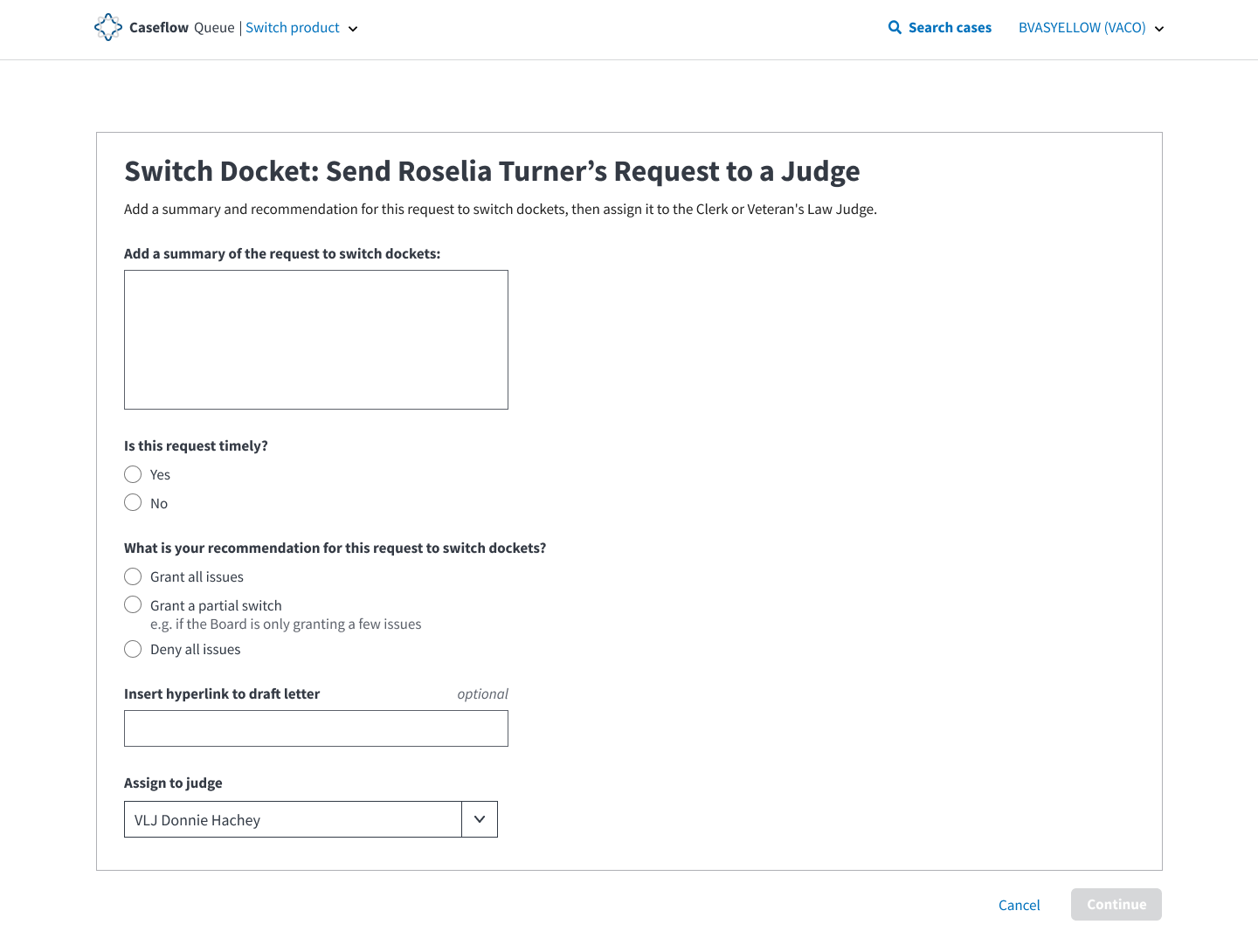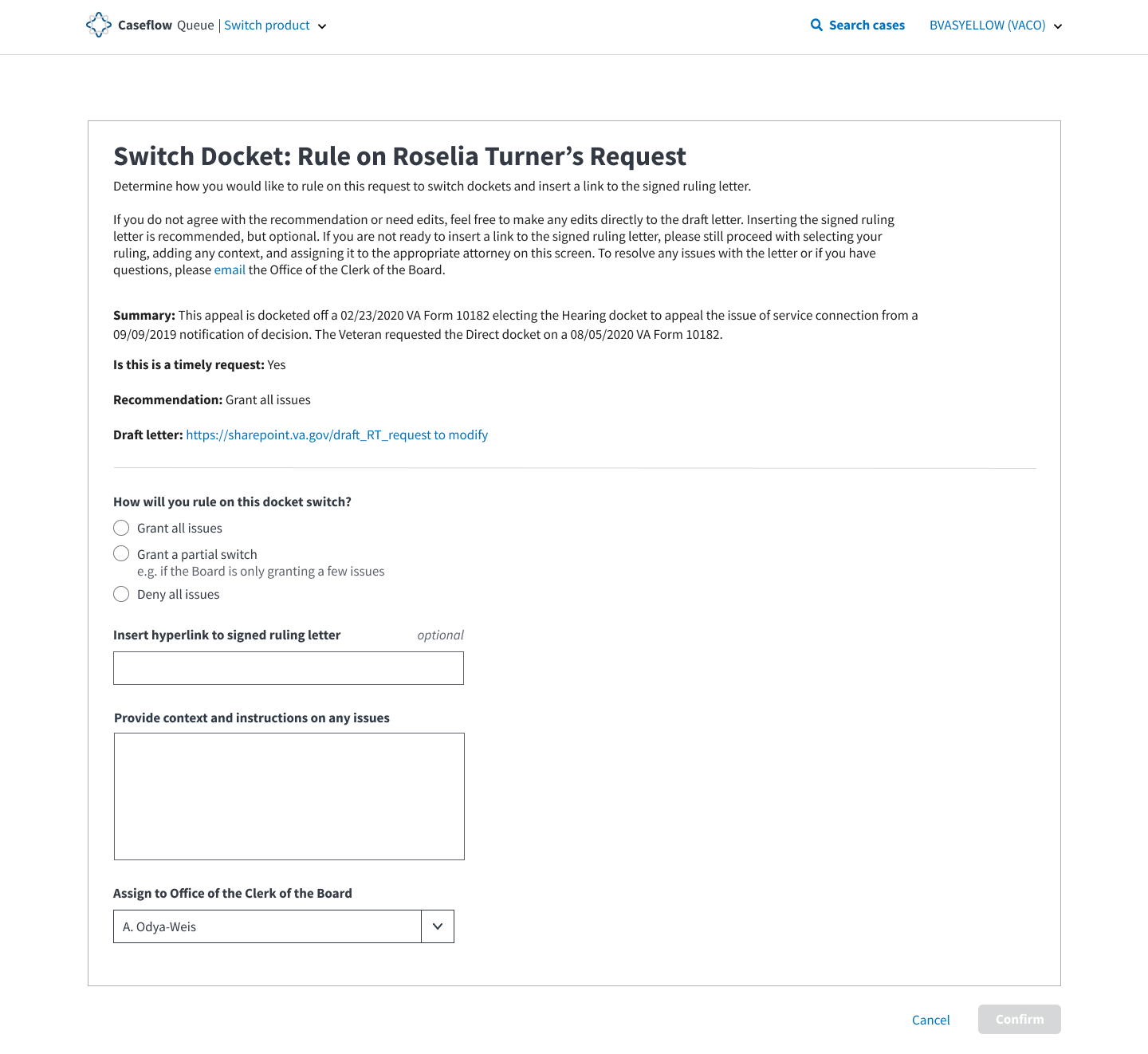Creating new ways of working at the Board of Veterans' Appeals
Summary
Caseflow is a suite of products that helps attorneys, judges, and administrative staff across the Department of Veterans Appeals process appeals and serve Veterans and other appellants more quickly, efficiently, and effectively. The Veterans Appeals Improvement and Modernization Act (AMA) – passed in 2017 and effective in 2019 – fundamentally changed how Veterans could appeal for benefits by giving them new/additional choices when they disagree with a VA claims decision.
In the summer of 2020, I began leading the research and design work for a new requirement for the Board of Veterans' Appeals (BVA) – enabling docket switches in Caseflow. Veterans had multiple pathways to appeal a decision issued by the Board – each was called a docket type. They could then submit a form to request a change to the docket type and our product, Caseflow needed to support this workflow.
Over the course of ~3 months, we conducted an extensive discovery and co-creation process. We iterated on the workflow and designs in close collaboration with two attorneys who would be the primary users of this functionality and our engineering teammates. Through this project, our team also lost 3 different product managers, resulting in design and engineering often needing to represent product strategy.
The outcome of this work was the replacement of a heavily manual process, thus saving attorneys a lot of time and effort – ultimately reducing the wait time for Veterans receiving a decision on their appeal. This also set a precedent for close and continuous collaboration with specific users within a team at the VA, which we were able to leverage and replicate for future streams of work.

Early workflow map to align on the current and future process
Key Contributions
- Led design and research activities over ~3 months, collaborating closely with our end users and engineering teammates
- Supported the team during product manager transitions by setting up weekly meetings to align on requirements and prioritization
- Piloted a co-creative way of working with our VA end users – shifting from a strictly usability testing model to co-creation and working sessions
- Paired closely with engineering to document technical decisions
- Led regular presentations to VA leadership
Key Outcomes
- Our co-creative ways of working were appreciated by the VA and adopted by other Caseflow teams
- We were able to rapidly discover, co-design, and implement a complex workflow for the Board of Veterans' Appeals that directly furthered their #1 priority of unblocking all AMA appeals
- Our work built a foundation for future work around handling complex tasks in Caseflow
Reflections
Co-creation is a powerful tool to quickly align and move forward, especially when a process is complex and ambiguous. Moving into a "let's figure this out together" model allowed us to build strong relationships with our end users and created shared ownership over the final implemented solution.
When in doubt - map it out (or write, or draw). Making an abstract or technical concept visual allowed us to have concrete conversations and align on a path forward. This project allowed me to refine my own practice and processes to work more effectively with engineering and form a strong partnership.
Process snapshot
As part of our co-creation process to develop this functionality, we created a mural that attorneys were able to fill out on their own. The mural (image below) captures details around tasks associated with each appeal track, and was an extremely useful artifact to help prompt the attorneys to think more deeply about technical details and implications.

After two discovery sessions with Board users, we mapped out their current process and co-created a future workflow with them to understand their vision, and help them imagine ways to streamline their process. This allowed the team to get input from end users early and often, and allowed them to directly inform the end solution. (Image below)
We held weekly usability testing sessions, and also experimented with asynchronous methods of gathering feedback, like previewing a presentation with designs and our open questions to gather input before our meeting. (Image below)


Our final implemented solution involved sending various tasks in Caseflow to over 3 types of teams and user types – making this one of the most complex features I led on Caseflow. We were able to rapidly deliver this functionality, ultimately saving significant time for Board users and Veterans awaiting their appeals decisions.
Here are a few sample designs of our functionality, illustrating an attorney sending a request to switch a docket to a judge, and a judge ruling on the decision.

